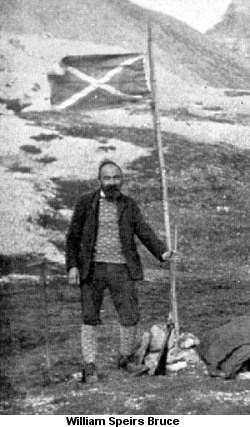
| Glasgow Digital Library | Voyage of the Scotia | BRUCE | PEOPLE | SHIP | ANTARCTIC | INDEX |
|---|

Antarctica was an unknown continent until the beginning of the 20th century when Scott, Shackleton and Wilson made the first journey into the continental interior. Today the knowledge of the Antarctic is truly amazing. The use of aircraft, radar, ice cores, atmospheric sampling, computer modelling of the atmosphere, underwater and under-ice surveys of the coastlines and satellite surveillance has greatly increased our knowledge of this vast continent. All of today's work is of a scientific nature.
The hazards of the Antarctic remain, but modern field parties are equipped with specialised clothing, skidoos, tents, radios, medical supplies, suitable food and support aircraft.
William Speirs Bruce was very much a man of the early part of the 20th century. He was immensely interested in science, devoted to exploration of the polar regions and an expert in so many physical and scientific fields: an oceanographer, zoologist, mapmaker, marine biologist, meteorologist and polar explorer. Bruce not only made a major contribution to our knowledge of polar regions but was a great influence both on his contemporaries and those who came after him. Several polar explorers read The Voyage of the Scotia before sailing to the Antarctic.
The greatest legacy of Bruce is the desire to find out more about the planet - to explore, to scientifically evaluate the environment and to understand the Earth. Understanding of the environment was essential to the early explorers, to those working in the Antarctic today and to ourselves, if the Earth is to continue to support the human race.
| Glasgow Digital Library | Voyage of the Scotia | BRUCE | PEOPLE | SHIP | ANTARCTIC | INDEX |
|---|